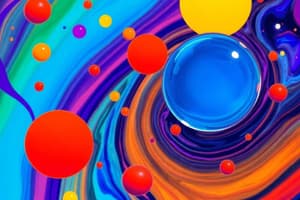Podcast
Questions and Answers
What phenomenon causes colloidal systems to scatter light, providing them with distinctive characteristics?
What phenomenon causes colloidal systems to scatter light, providing them with distinctive characteristics?
- Tyndall effect (correct)
- Osmotic pressure
- Sedimentation
- Brownian motion
Which of the following methods can be used to separate colloidal particles from a solution?
Which of the following methods can be used to separate colloidal particles from a solution?
- Sedimentation
- Dialysis (correct)
- Evaporation
- Ordinary filtration
Which statement accurately describes the diffusion characteristics of colloidal dispersions compared to solutions and suspensions?
Which statement accurately describes the diffusion characteristics of colloidal dispersions compared to solutions and suspensions?
- Colloidal dispersions have a higher rate of diffusion than solutions.
- Colloidal dispersions exhibit Brownian motion, while suspensions do not. (correct)
- Solutions do not exhibit any diffusion behavior.
- Suspensions have a lower rate of diffusion than colloidal dispersions.
What is the maximum particle size limit for solid aerosols to ensure proper absorption behavior?
What is the maximum particle size limit for solid aerosols to ensure proper absorption behavior?
Which type of mixture demonstrates no osmotic pressure, distinguishing it from colloids and solutions?
Which type of mixture demonstrates no osmotic pressure, distinguishing it from colloids and solutions?
What characterizes lyophobic dispersions compared to lyophilic dispersions?
What characterizes lyophobic dispersions compared to lyophilic dispersions?
Which factor primarily controls the stability of lyophobic dispersions?
Which factor primarily controls the stability of lyophobic dispersions?
How does the formation of lyophobic dispersions generally occur?
How does the formation of lyophobic dispersions generally occur?
What is true about the electric charges on particles in stable colloidal systems?
What is true about the electric charges on particles in stable colloidal systems?
Which statement about lyophilic materials is correct?
Which statement about lyophilic materials is correct?
What phenomenon is used to determine the molecular weight of colloids through light scattering?
What phenomenon is used to determine the molecular weight of colloids through light scattering?
Which of the following processes can cause colloidal particles to acquire a surface electric charge?
Which of the following processes can cause colloidal particles to acquire a surface electric charge?
In the process of electrophoresis, charged particles in a colloid migrate toward which type of electrode?
In the process of electrophoresis, charged particles in a colloid migrate toward which type of electrode?
What is the main difference between imbibition and swelling in gels?
What is the main difference between imbibition and swelling in gels?
What characterizes xerogels?
What characterizes xerogels?
What characterizes lyophobic materials in terms of colloidal dispersion?
What characterizes lyophobic materials in terms of colloidal dispersion?
Which of the following processes is NOT involved in the preparation of lyophobic sols?
Which of the following processes is NOT involved in the preparation of lyophobic sols?
What occurs when the concentration of amphiphile exceeds the critical micelle concentration?
What occurs when the concentration of amphiphile exceeds the critical micelle concentration?
Which statement about lyophilic sols is true regarding their behavior upon coagulation?
Which statement about lyophilic sols is true regarding their behavior upon coagulation?
What is a key difference between lyophobic and lyophilic preparations?
What is a key difference between lyophobic and lyophilic preparations?
Which method is associated with the preparation of lyophobic sols?
Which method is associated with the preparation of lyophobic sols?
What is the result of high net inter-particle attraction in lyophobic sols?
What is the result of high net inter-particle attraction in lyophobic sols?
What happens to lyophobic systems at high concentrations?
What happens to lyophobic systems at high concentrations?
What effect describes the scattering of light by colloidal particles when a strong beam of light passes through a colloidal sol?
What effect describes the scattering of light by colloidal particles when a strong beam of light passes through a colloidal sol?
Which property allows for the determination of molecular weight or particle size in colloidal systems?
Which property allows for the determination of molecular weight or particle size in colloidal systems?
What is the primary reason the sky appears blue according to the scattering of light?
What is the primary reason the sky appears blue according to the scattering of light?
What happens to lyophobic colloidal particles when sufficient amounts of polymer are added?
What happens to lyophobic colloidal particles when sufficient amounts of polymer are added?
What is the consequence of low osmotic pressure in colloidal dispersions?
What is the consequence of low osmotic pressure in colloidal dispersions?
According to Rayleigh law, how does the intensity of scatter light change with varying wavelengths?
According to Rayleigh law, how does the intensity of scatter light change with varying wavelengths?
What causes sedimentation in colloidal solutions under gravity or a centrifugal field?
What causes sedimentation in colloidal solutions under gravity or a centrifugal field?
What role does the refractive index play in determining the optical properties of a colloidal dispersion?
What role does the refractive index play in determining the optical properties of a colloidal dispersion?
What is the primary characteristic of lyophobic sols?
What is the primary characteristic of lyophobic sols?
What type of charge do the flat faces of bentonite particles carry?
What type of charge do the flat faces of bentonite particles carry?
Which of the following forces is primarily responsible for holding clay-based gels together?
Which of the following forces is primarily responsible for holding clay-based gels together?
What phenomenon is exhibited by gels due to the weak forces holding particles together?
What phenomenon is exhibited by gels due to the weak forces holding particles together?
In terms of shape, how do most colloidal systems containing solid particles behave?
In terms of shape, how do most colloidal systems containing solid particles behave?
How does the shape of hydrophilic colloidal particles affect their interaction with the dispersion medium?
How does the shape of hydrophilic colloidal particles affect their interaction with the dispersion medium?
Which of the following substances forms gels through the process of flocculation?
Which of the following substances forms gels through the process of flocculation?
What best describes the structure formed by the electrostatic attraction between clay particles?
What best describes the structure formed by the electrostatic attraction between clay particles?
Flashcards
Colloidal Dispersion
Colloidal Dispersion
A mixture where particles are evenly distributed but too small to be seen with the naked eye, appearing homogeneous but are actually heterogeneous.
Tyndall Effect
Tyndall Effect
The scattering of light by particles in a colloidal dispersion, making the beam visible. This distinguishes colloids from true solutions.
Ultrafiltration
Ultrafiltration
A type of filtration that uses a membrane to separate larger particles from a solution
Absorption of Light
Absorption of Light
Signup and view all the flashcards
Particle Size and Absorption
Particle Size and Absorption
Signup and view all the flashcards
Lyophilicity
Lyophilicity
Signup and view all the flashcards
Lyophobic
Lyophobic
Signup and view all the flashcards
Coagulation of Lyophobic Sols
Coagulation of Lyophobic Sols
Signup and view all the flashcards
Lyophobic Pastes
Lyophobic Pastes
Signup and view all the flashcards
Association (Amphiphilic) Colloids
Association (Amphiphilic) Colloids
Signup and view all the flashcards
Lyophilic Colloids
Lyophilic Colloids
Signup and view all the flashcards
Lyophobic Colloid Preparation
Lyophobic Colloid Preparation
Signup and view all the flashcards
Lyophilic Colloid Preparation
Lyophilic Colloid Preparation
Signup and view all the flashcards
Stability of Lyophobic Colloids
Stability of Lyophobic Colloids
Signup and view all the flashcards
Stability of Lyophilic Colloids
Stability of Lyophilic Colloids
Signup and view all the flashcards
Formation of Colloidal Dispersions
Formation of Colloidal Dispersions
Signup and view all the flashcards
Brownian Motion
Brownian Motion
Signup and view all the flashcards
Rayleigh Law
Rayleigh Law
Signup and view all the flashcards
Steric stabilization
Steric stabilization
Signup and view all the flashcards
Sedimentation
Sedimentation
Signup and view all the flashcards
Osmosis
Osmosis
Signup and view all the flashcards
Ultracentrifugation
Ultracentrifugation
Signup and view all the flashcards
Electrophoresis
Electrophoresis
Signup and view all the flashcards
Swelling
Swelling
Signup and view all the flashcards
Viscosity
Viscosity
Signup and view all the flashcards
Osmotic Pressure
Osmotic Pressure
Signup and view all the flashcards
Lyophobic sols
Lyophobic sols
Signup and view all the flashcards
Flocculation of Lyophobic sols
Flocculation of Lyophobic sols
Signup and view all the flashcards
Clay Gels (Bentonite, Veegum)
Clay Gels (Bentonite, Veegum)
Signup and view all the flashcards
Shape of Colloidal Particles
Shape of Colloidal Particles
Signup and view all the flashcards
High Molecular Weight Polymers in Solution
High Molecular Weight Polymers in Solution
Signup and view all the flashcards
Thixotropy
Thixotropy
Signup and view all the flashcards
Forces Holding Lyophobic Gels Together
Forces Holding Lyophobic Gels Together
Signup and view all the flashcards
Study Notes
Introduction to Colloidal Dispersions
- Colloidal dispersions are heterogeneous systems composed of a dispersed phase (small particles) within a dispersion medium (continuous phase).
- Particle size in colloidal dispersions ranges from 1nm to 1000nm.
- True solutions have particles <1nm.
- Fine dispersions have particles between 0.5µm to 10µm.
- Coarse dispersions have particles between 10µm and 50µm.
Classification of Colloidal Dispersions
- Physical states of dispersed phase and continuous medium
- Particle size
- Interactions between dispersed and continuous medium
Types of Colloidal Dispersions
- Gas dispersed in liquid: Examples: foams (whipped cream); aerosols (fog).
- Liquid dispersed in liquid: Examples: emulsions (milk); lotions.
- Solid dispersed in liquid: Examples: sols (blood); suspensions (antacids).
- Gas dispersed in solid: Examples: aerogels.
- Liquid dispersed in solid: Examples: gels (agar, gelatin); solid foams (styrofoam)
- Solid dispersed in solid: Examples: solid suspensions/sols (coloured glass)
Particle Size and Size Distribution
- Particle size affects absorption behavior.
- Solid aerosols' particles must be between 1–5µm, and no particles above 10µm.
- Measured by osmotic pressure or light scattering.
- Spherical particles size determined by diameter.
- Asymmetrical particles measured by Stoke's diameter (equivalent spherical particle).
Interaction Between Dispersed Phase and Dispersion Medium
- Lyophilic: "liquid loving"
- Lyophobic: "liquid hating"
- Association colloids (amphiphilic): Possess both hydrophobic and hydrophilic properties, forming aggregates (micelles) in solution.
Dispersion Medium is Water
- Hydrophilic colloids disperse spontaneously in water and readily swell (high affinity to water).
- Hydrophobic colloids need stabilizing agents to disperse in water.
Lyophilic vs Lyophobic Interactions
- Lyophobic colloids show weak interactions with the dispersion medium, whereas lyophilic colloids demonstrate strong attractive forces between the dispersed phase and the dispersion medium.
- Lyophilic colloids are usually stable and readily dispersed in the presence or absence of electrolytes.
- Lyophobic colloids are sensitive to electrolytes and require special preparation methods.
Lyophobic Colloidal Preparations
- Cannot be prepared directly, but rather by specialized techniques to control particle size.
- Techniques—mechanical reduction and condensation
- Stabilizers are frequently needed to obtain stable lyophobic dispersions.
Lyophobic and Lyophilic Dispersion Formation and Stability
- Lyophobic dispersions are thermodynamically unstable, require special methods to form, and are often stabilized by external factors like charge repulsion.
- Lyophilic dispersions are usually stable in any medium, and more easily prepared.
Effect of Electrolytes and Macromolecular Additives
- Electrolytes affect lyophobic dispersions, often leading to aggregation or precipitation.
- Stabilizing agents and macromolecules can help prevent aggregation or promote stability in lyophilic or lyophobic sols.
Colloid Properties for Molecular Weight Determination and Optical Properties
- Techniques like Tyndall effect, viscosity, and osmotic pressure can be used to determine molecular weight of colloidal particles.
- Optical properties like the Tyndall effect can be used to determine particle size.
Electrical Properties of Colloids
- Surfaces of particles often acquire a positive or negative electric charge when interacting with an aqueous medium. This charge is crucial to stability and behavior of colloids.
- Ionization and adsorption processes contribute to surface charge.
Electrophoresis
- Electrophoresis measures the movement of charged particles in a colloidal dispersion under an applied electric field. This technique measures the zeta potential.
Terminology
- Imbibition: Absorption of a liquid by a solid or gel, often without substantial expansion.
- Swelling: Increase in volume due to liquid retention in a gel.
- Syneresis: Separation of liquid by a gel due to internal particle interactions.
- Xerogels: Gels formed after the removal of liquid, which retain the internal framework of the original gel.
Dispersion of Lyophobic Sols
Dispersion of Lyophobic Sols
- Lyophobic sols often exhibit flocculation (aggregation)
- Flocculation can result in 2 phase system—continuous floccule.
- Stabilizing agents are needed for uniform disperson
Shape of Colloidal Particles
- Hydrophobic particles may be spherical, ellipsoidal, or plate-like
- Hydrophilic particles may be more extended structures.
- Shape affects properties like flow, sedimentation, and osmotic pressure and can affect pharmacological action.
Studying That Suits You
Use AI to generate personalized quizzes and flashcards to suit your learning preferences.





